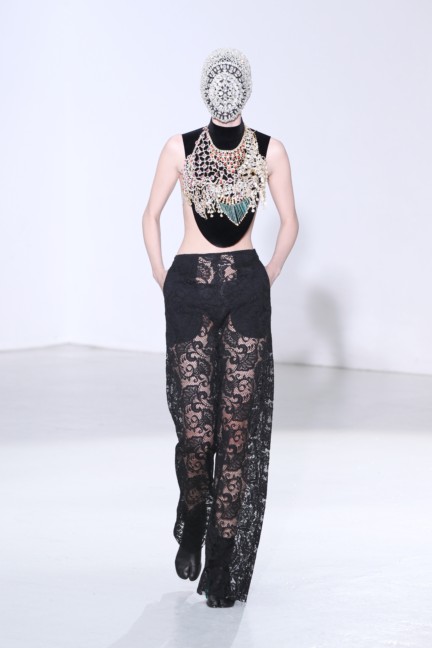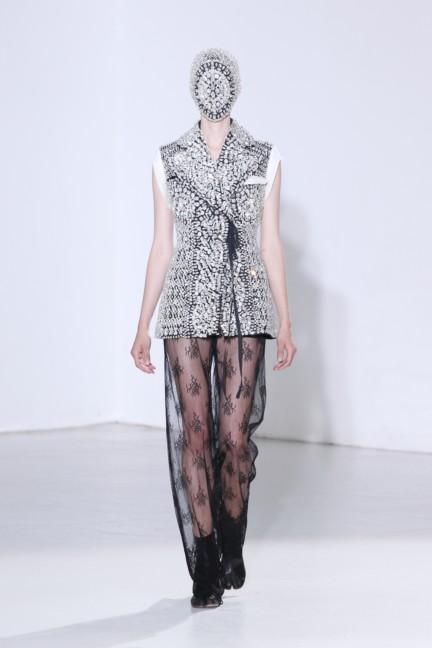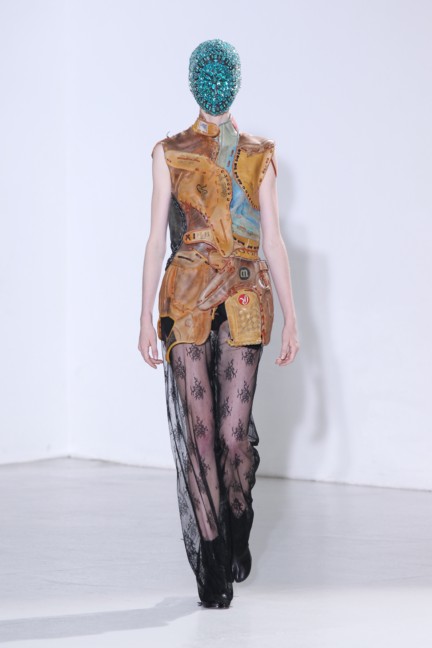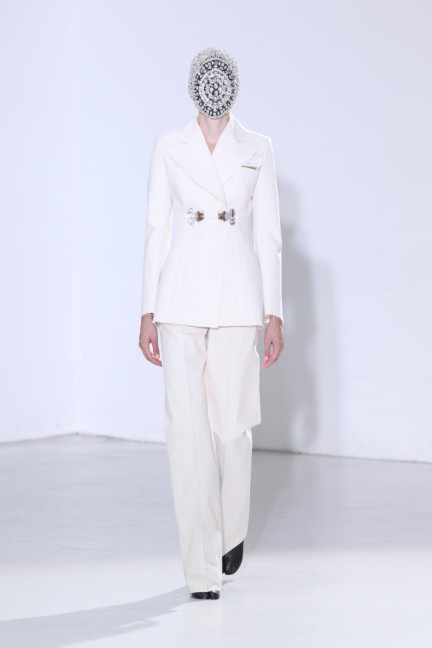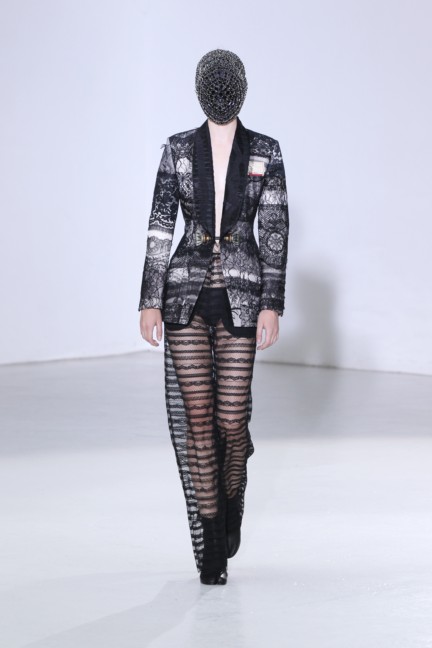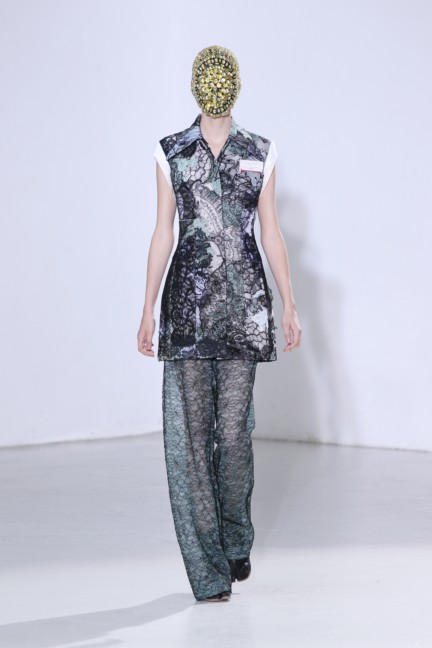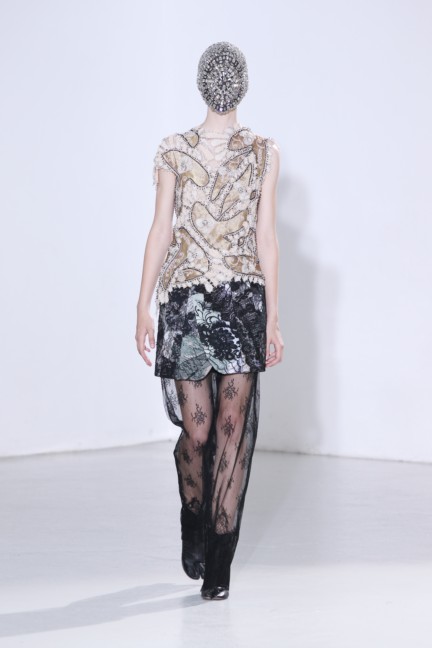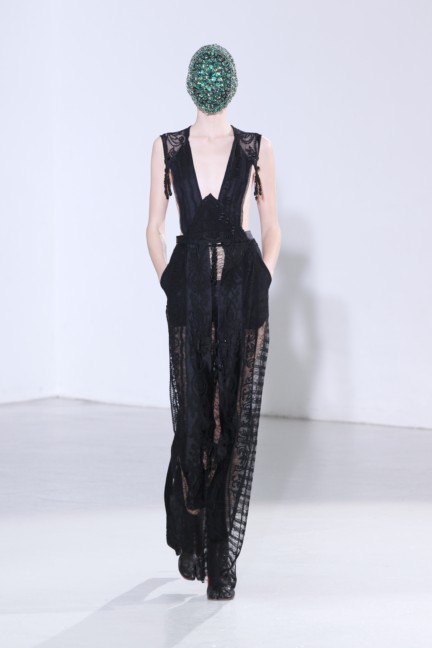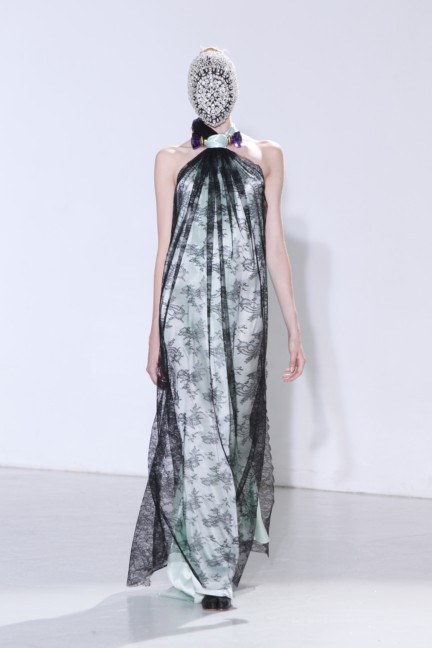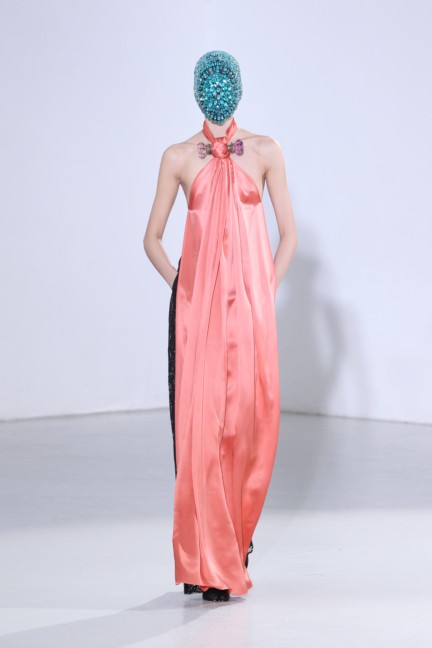MAISON MARTIN MARGIELA
“To Evolve Is To Continue to Breathe Creatively” – Martin Margiela
Martin Margiela was born in 1959, in Limbourg, Belgium. He studied at Antswerp’s Royal Academy and went on to assist Jean Paul Gaultier in the early 1980′s. Maison Martin Margiela was founded in 1988, and has since chosen to ‘let his brand do the talking’. It is said that he was an intensely private person, who hardly ever gave interviews, or had his photograph taken. Although the Maison Martin Margiela brand was acquired by the Diesel brand in 2002, no creative director has since been appointed, and a design team have replaced him, which, it is felt, continue to carry the enthusiasm and ‘Margiela Magic’ into the current era.
Clothing retailer H & M announced in June 2012 of a collaboration between their stores and the Maison Martin Margiela fashion house. It is said that at the beginning of November a collection of Margiela clothing accessories for both men and women will be sold in H & M stores worldwide.
His intriguing designs and exhaustive attention to detail continue to capture the imaginations of audiences worldwide through the efforts of his superb creative team.
We feel sure that budding fashion designers everywhere would like to read on so that they can fully appreciate the work and authenticity which goes into the production of an extremely successful Haute Couture collection. (We have graciously been sent a piece of Press Release ‘Gold’ by Maison Martin Margiela, detailing all of the processing and materials used which have gone into producing this amazing Autumn/Winter 2012/13 Haute Couture Collection shown below). So Enjoy!
MAISON MARTIN MARGIELA - “ARTISANAL”
Since it’s founding in 1988, Maison Martin Margiela has collected used, and sometimes new, clothing, accessories and objects from around the world. Indeed, one of the cornerstones of the Maison’s creative expression is resurrecting these vintage pieces and recasting them in a new way that preserves the mark of time. In addition to restoring and reworking these items, they are also reinterpreted in new fabrics. Each piece is made entirely by hand in the Maison’s artisanal atelier.
The eccentricity of materials used and the complex and particular processes necessary at each stage of transformation, naturally limit quantities and ensure the unique character of each of these pieces.
An anachronistic silhouette was built for this collection by confronting clothing, fabrics and objects originating from the turn of the XXth century, with more contemporary shapes, volumes and raw materials.
Look 1) Veste Tailleur
A sleeveless tailored jacket inspired from a 1905 tailcoat found in the South of France, is cut in “Calico” (a raw cotton material). An Edwardian crystal door-knob becomes a brooch, to fasten the jacket. It took 38 hours to produce this piece. Materials used were cotton, bronze and crystal door-knob which was sourced in New York.
Look 2) Tailleur Pantalon
A tailored jacket and straight trousers are again cut in “Calico”. An Edwardian crystal door-knob becomes a brooch, closing the jacket. It took 24 hours in production time for the jacket, and 8 hours for the trousers. Materials used were cotton, bronze and crystal door-knob which becomes a brooch to fasten the jacket.
Look3) Smoking
A smoking jacket made from several sources of Edwardian lace is worn over lace trousers. The jacket’s pleated lapel is made fron one of the former dress’ satin underskirts. An Edwardian crystal door-knob once again becoming a brooch to fasten the jacket. This jacket took 61 hours to produce. The lace originates from Great Britain, Chantilly, Bruges and Calais, France, and Belgium. The cotton, bronze and crystal door-know were all sourced in New York.
Look 4) Manteau
A sleeveless coat, cut from a patchwork of lace and Art Nouveau dresses is worn over lace trousers. The antique lace is restored and reassembled to create a vegetal pattern. The production time for this piece was 96 hours for the coat. Lace: Chantilly, Bruges and Calais, sourced in France, Belgium and Great Britain.
Look 5) Veste Tailleur A Basque Jupe
A basque jacket and skirt are cut from several silk and lace period dresses, dating back to the early XXth centrury and from lace veils made by Weiner Werkstatte. An Edwardian crystal door-knob fastens the jacket. The production time was 89 hours for the jacket and 15 hours for the lace skirt. The lace, Chantilly, Bruges and Calais, sourced in Great Britain, France and Belgium. The lace veils were from a private collection in Paris. The cotton, bronze and crystal door knobs were sourced in New York.
Look 6) Ensemble
A mass of embroidery – with designs attributed to Paul Poiret and created by the master passementier Prevost is gathered to recreate an open-back blouse, which is worn over lace trousers and under a wrap-around skirt made from a patchwork of lace and Edwardian dresses. The production time for this garment was 20 hours for the blouse and 15 hours for the skirt. The embroidery was found in a Parisian antiquary.
Look 7) Ensemble Du Soir
An Edwardian tailor-made gown is opened up, restored and reassembled. Only the outer layer is conserved, creating a chasuble dress worn over lace trousers. The production time was 30 hours for the dress. The garment itself was originally made between 1900 and 1910 by L Deleplanque, a tailor from Brussels.
Look 8) Robe Du Soir
A cut of antique lace is lined with silk and tied around two Edwardian door-knobs to create an evening dress. The production time was 12 hours. The antique lace was found in Senlis, France. Bronze and crystal door-knob once again sourced in France.
Look 9) Robe Tablier
A cut of silk is tied around a crystal Edwardian door-knob to become a backless evening dress, worn over lace trounsers. The production time was 6 hours for the dress. Bronze and crystal door-knob sourced in New York.
Look 10) Plastron
Antique costume jewellery from the Opera de Paris’ early XXth century supplier Le Blanc-Granget, is assembled on a velvet covered leather bib. The production time was 16 hours for the bib, and the jewellery was sourced from France’s Saint-Ouen flea market.
Look 11) Veste Tailleur Plastron
Asleeveless suit jacket is completely re-embroidered with rhinestones and antique crystals. It is wornover lace trousers. The production time was 88 hours for the jacket. The rhinestones and crystals were found in Paris. Once again, bronze and crystal door-knob sourced in New York.
Look 12) Bombers
An antique tailor-made silk gown, embroidered with an Art Nouveau vegetal pattern is restored and transformed to become alonge evening bomber jacket. Production time was 140 hours for the bomber jacket. Tailor Andrea Jamet’s dress is estimated to date from between 1905 and 1909 in Saint-Etienne, France.
Look 13) Ensemble
A bolero made from several vintage leather baseball gloves is worn with lace trousers and over a Prevost embroidered blouse. Production time: 48 hours for the bolero and 23 houjrs for the blouse. The vintage baseball gloves are from the U.S.A. The embroidery was found in a Parisian antiquary, production estimated between 1905 and 1915.
Look 14) Blouson En Cuir
A coat cut from a windsurfing board’s sail is tailored to reproduce the volume of a 1910man’s overcoat and is worn over lace trousers. Production time was 51 hours for the coat. Materials used were PVC, reinforced plastic, nylon and metal.
The different lace on each pair of trousers was sourced from renowned French lacemakers. The production time for each pair of lace trousers was 9 hours.
The veils lightly covering the models’ faces were embroidered in the Maison Martin Margiela’s own Parisian atelier.
The costume’s handkerchiefs were made from swatches of upholstery fabric, coming from the Printemps Haussman, the Grands Magasins du Louvre, and the Bon Marche between 1900 and 1910.
Fabric Restoration
The number of hours work reflects only the time required to produce these pieces, not fabric research nor the many treatments needed to ennoble them.
With thanks to Dahlia Khodari at Karla Otto & Victoria Langevin at Maison Martin Margiela.
MAISON MARTIN MARGIELA
“To Evolve Is To Continue to Breathe Creatively” – Martin Margiela
Martin Margiela was born in 1959, in Limbourg, Belgium. He studied at Antswerp’s Royal Academy and went on to assist Jean Paul Gaultier in the early 1980′s. Maison Martin Margiela was founded in 1988, and has since chosen to ‘let his brand do the talking’. It is said that he was an intensely private person, who hardly ever gave interviews, or had his photograph taken. Although the Maison Martin Margiela brand was acquired by the Diesel brand in 2002, no creative director has since been appointed, and a design team have replaced him, which, it is felt, continue to carry the enthusiasm and ‘Margiela Magic’ into the current era.
Clothing retailer H & M announced in June 2012 of a collaboration between their stores and the Maison Martin Margiela fashion house. It is said that at the beginning of November a collection of Margiela clothing accessories for both men and women will be sold in H & M stores worldwide.
His intriguing designs and exhaustive attention to detail continue to capture the imaginations of audiences worldwide through the efforts of his superb creative team.
We feel sure that budding fashion designers everywhere would like to read on so that they can fully appreciate the work and authenticity which goes into the production of an extremely successful Haute Couture collection. (We have graciously been sent a piece of Press Release ‘Gold’ by Maison Martin Margiela, detailing all of the processing and materials used which have gone into producing this amazing Autumn/Winter 2012/13 Haute Couture Collection shown below). So Enjoy!
MAISON MARTIN MARGIELA - “ARTISANAL”
Since it’s founding in 1988, Maison Martin Margiela has collected used, and sometimes new, clothing, accessories and objects from around the world. Indeed, one of the cornerstones of the Maison’s creative expression is resurrecting these vintage pieces and recasting them in a new way that preserves the mark of time. In addition to restoring and reworking these items, they are also reinterpreted in new fabrics. Each piece is made entirely by hand in the Maison’s artisanal atelier.
The eccentricity of materials used and the complex and particular processes necessary at each stage of transformation, naturally limit quantities and ensure the unique character of each of these pieces.
An anachronistic silhouette was built for this collection by confronting clothing, fabrics and objects originating from the turn of the XXth century, with more contemporary shapes, volumes and raw materials.
Look 1) Veste Tailleur
A sleeveless tailored jacket inspired from a 1905 tailcoat found in the South of France, is cut in “Calico” (a raw cotton material). An Edwardian crystal door-knob becomes a brooch, to fasten the jacket. It took 38 hours to produce this piece. Materials used were cotton, bronze and crystal door-knob which was sourced in New York.
Look 2) Tailleur Pantalon
A tailored jacket and straight trousers are again cut in “Calico”. An Edwardian crystal door-knob becomes a brooch, closing the jacket. It took 24 hours in production time for the jacket, and 8 hours for the trousers. Materials used were cotton, bronze and crystal door-knob which becomes a brooch to fasten the jacket.
Look3) Smoking
A smoking jacket made from several sources of Edwardian lace is worn over lace trousers. The jacket’s pleated lapel is made fron one of the former dress’ satin underskirts. An Edwardian crystal door-knob once again becoming a brooch to fasten the jacket. This jacket took 61 hours to produce. The lace originates from Great Britain, Chantilly, Bruges and Calais, France, and Belgium. The cotton, bronze and crystal door-know were all sourced in New York.
Look 4) Manteau
A sleeveless coat, cut from a patchwork of lace and Art Nouveau dresses is worn over lace trousers. The antique lace is restored and reassembled to create a vegetal pattern. The production time for this piece was 96 hours for the coat. Lace: Chantilly, Bruges and Calais, sourced in France, Belgium and Great Britain.
Look 5) Veste Tailleur A Basque Jupe
A basque jacket and skirt are cut from several silk and lace period dresses, dating back to the early XXth centrury and from lace veils made by Weiner Werkstatte. An Edwardian crystal door-knob fastens the jacket. The production time was 89 hours for the jacket and 15 hours for the lace skirt. The lace, Chantilly, Bruges and Calais, sourced in Great Britain, France and Belgium. The lace veils were from a private collection in Paris. The cotton, bronze and crystal door knobs were sourced in New York.
Look 6) Ensemble
A mass of embroidery – with designs attributed to Paul Poiret and created by the master passementier Prevost is gathered to recreate an open-back blouse, which is worn over lace trousers and under a wrap-around skirt made from a patchwork of lace and Edwardian dresses. The production time for this garment was 20 hours for the blouse and 15 hours for the skirt. The embroidery was found in a Parisian antiquary.
Look 7) Ensemble Du Soir
An Edwardian tailor-made gown is opened up, restored and reassembled. Only the outer layer is conserved, creating a chasuble dress worn over lace trousers. The production time was 30 hours for the dress. The garment itself was originally made between 1900 and 1910 by L Deleplanque, a tailor from Brussels.
Look 8) Robe Du Soir
A cut of antique lace is lined with silk and tied around two Edwardian door-knobs to create an evening dress. The production time was 12 hours. The antique lace was found in Senlis, France. Bronze and crystal door-knob once again sourced in France.
Look 9) Robe Tablier
A cut of silk is tied around a crystal Edwardian door-knob to become a backless evening dress, worn over lace trounsers. The production time was 6 hours for the dress. Bronze and crystal door-knob sourced in New York.
Look 10) Plastron
Antique costume jewellery from the Opera de Paris’ early XXth century supplier Le Blanc-Granget, is assembled on a velvet covered leather bib. The production time was 16 hours for the bib, and the jewellery was sourced from France’s Saint-Ouen flea market.
Look 11) Veste Tailleur Plastron
Asleeveless suit jacket is completely re-embroidered with rhinestones and antique crystals. It is wornover lace trousers. The production time was 88 hours for the jacket. The rhinestones and crystals were found in Paris. Once again, bronze and crystal door-knob sourced in New York.
Look 12) Bombers
An antique tailor-made silk gown, embroidered with an Art Nouveau vegetal pattern is restored and transformed to become alonge evening bomber jacket. Production time was 140 hours for the bomber jacket. Tailor Andrea Jamet’s dress is estimated to date from between 1905 and 1909 in Saint-Etienne, France.
Look 13) Ensemble
A bolero made from several vintage leather baseball gloves is worn with lace trousers and over a Prevost embroidered blouse. Production time: 48 hours for the bolero and 23 houjrs for the blouse. The vintage baseball gloves are from the U.S.A. The embroidery was found in a Parisian antiquary, production estimated between 1905 and 1915.
Look 14) Blouson En Cuir
A coat cut from a windsurfing board’s sail is tailored to reproduce the volume of a 1910man’s overcoat and is worn over lace trousers. Production time was 51 hours for the coat. Materials used were PVC, reinforced plastic, nylon and metal.
The different lace on each pair of trousers was sourced from renowned French lacemakers. The production time for each pair of lace trousers was 9 hours.
The veils lightly covering the models’ faces were embroidered in the Maison Martin Margiela’s own Parisian atelier.
The costume’s handkerchiefs were made from swatches of upholstery fabric, coming from the Printemps Haussman, the Grands Magasins du Louvre, and the Bon Marche between 1900 and 1910.
Fabric Restoration
The number of hours work reflects only the time required to produce these pieces, not fabric research nor the many treatments needed to ennoble them.
With thanks to Dahlia Khodari at Karla Otto & Victoria Langevin at Maison Martin Margiela.
MAISON MARTIN MARGIELA
“To Evolve Is To Continue to Breathe Creatively” – Martin Margiela
Martin Margiela was born in 1959, in Limbourg, Belgium. He studied at Antswerp’s Royal Academy and went on to assist Jean Paul Gaultier in the early 1980′s. Maison Martin Margiela was founded in 1988, and has since chosen to ‘let his brand do the talking’. It is said that he was an intensely private person, who hardly ever gave interviews, or had his photograph taken. Although the Maison Martin Margiela brand was acquired by the Diesel brand in 2002, no creative director has since been appointed, and a design team have replaced him, which, it is felt, continue to carry the enthusiasm and ‘Margiela Magic’ into the current era.
Clothing retailer H & M announced in June 2012 of a collaboration between their stores and the Maison Martin Margiela fashion house. It is said that at the beginning of November a collection of Margiela clothing accessories for both men and women will be sold in H & M stores worldwide.
His intriguing designs and exhaustive attention to detail continue to capture the imaginations of audiences worldwide through the efforts of his superb creative team.
We feel sure that budding fashion designers everywhere would like to read on so that they can fully appreciate the work and authenticity which goes into the production of an extremely successful Haute Couture collection. (We have graciously been sent a piece of Press Release ‘Gold’ by Maison Martin Margiela, detailing all of the processing and materials used which have gone into producing this amazing Autumn/Winter 2012/13 Haute Couture Collection shown below). So Enjoy!
MAISON MARTIN MARGIELA - “ARTISANAL”
Since it’s founding in 1988, Maison Martin Margiela has collected used, and sometimes new, clothing, accessories and objects from around the world. Indeed, one of the cornerstones of the Maison’s creative expression is resurrecting these vintage pieces and recasting them in a new way that preserves the mark of time. In addition to restoring and reworking these items, they are also reinterpreted in new fabrics. Each piece is made entirely by hand in the Maison’s artisanal atelier.
The eccentricity of materials used and the complex and particular processes necessary at each stage of transformation, naturally limit quantities and ensure the unique character of each of these pieces.
An anachronistic silhouette was built for this collection by confronting clothing, fabrics and objects originating from the turn of the XXth century, with more contemporary shapes, volumes and raw materials.
Look 1) Veste Tailleur
A sleeveless tailored jacket inspired from a 1905 tailcoat found in the South of France, is cut in “Calico” (a raw cotton material). An Edwardian crystal door-knob becomes a brooch, to fasten the jacket. It took 38 hours to produce this piece. Materials used were cotton, bronze and crystal door-knob which was sourced in New York.
Look 2) Tailleur Pantalon
A tailored jacket and straight trousers are again cut in “Calico”. An Edwardian crystal door-knob becomes a brooch, closing the jacket. It took 24 hours in production time for the jacket, and 8 hours for the trousers. Materials used were cotton, bronze and crystal door-knob which becomes a brooch to fasten the jacket.
Look3) Smoking
A smoking jacket made from several sources of Edwardian lace is worn over lace trousers. The jacket’s pleated lapel is made fron one of the former dress’ satin underskirts. An Edwardian crystal door-knob once again becoming a brooch to fasten the jacket. This jacket took 61 hours to produce. The lace originates from Great Britain, Chantilly, Bruges and Calais, France, and Belgium. The cotton, bronze and crystal door-know were all sourced in New York.
Look 4) Manteau
A sleeveless coat, cut from a patchwork of lace and Art Nouveau dresses is worn over lace trousers. The antique lace is restored and reassembled to create a vegetal pattern. The production time for this piece was 96 hours for the coat. Lace: Chantilly, Bruges and Calais, sourced in France, Belgium and Great Britain.
Look 5) Veste Tailleur A Basque Jupe
A basque jacket and skirt are cut from several silk and lace period dresses, dating back to the early XXth centrury and from lace veils made by Weiner Werkstatte. An Edwardian crystal door-knob fastens the jacket. The production time was 89 hours for the jacket and 15 hours for the lace skirt. The lace, Chantilly, Bruges and Calais, sourced in Great Britain, France and Belgium. The lace veils were from a private collection in Paris. The cotton, bronze and crystal door knobs were sourced in New York.
Look 6) Ensemble
A mass of embroidery – with designs attributed to Paul Poiret and created by the master passementier Prevost is gathered to recreate an open-back blouse, which is worn over lace trousers and under a wrap-around skirt made from a patchwork of lace and Edwardian dresses. The production time for this garment was 20 hours for the blouse and 15 hours for the skirt. The embroidery was found in a Parisian antiquary.
Look 7) Ensemble Du Soir
An Edwardian tailor-made gown is opened up, restored and reassembled. Only the outer layer is conserved, creating a chasuble dress worn over lace trousers. The production time was 30 hours for the dress. The garment itself was originally made between 1900 and 1910 by L Deleplanque, a tailor from Brussels.
Look 8) Robe Du Soir
A cut of antique lace is lined with silk and tied around two Edwardian door-knobs to create an evening dress. The production time was 12 hours. The antique lace was found in Senlis, France. Bronze and crystal door-knob once again sourced in France.
Look 9) Robe Tablier
A cut of silk is tied around a crystal Edwardian door-knob to become a backless evening dress, worn over lace trounsers. The production time was 6 hours for the dress. Bronze and crystal door-knob sourced in New York.
Look 10) Plastron
Antique costume jewellery from the Opera de Paris’ early XXth century supplier Le Blanc-Granget, is assembled on a velvet covered leather bib. The production time was 16 hours for the bib, and the jewellery was sourced from France’s Saint-Ouen flea market.
Look 11) Veste Tailleur Plastron
Asleeveless suit jacket is completely re-embroidered with rhinestones and antique crystals. It is wornover lace trousers. The production time was 88 hours for the jacket. The rhinestones and crystals were found in Paris. Once again, bronze and crystal door-knob sourced in New York.
Look 12) Bombers
An antique tailor-made silk gown, embroidered with an Art Nouveau vegetal pattern is restored and transformed to become alonge evening bomber jacket. Production time was 140 hours for the bomber jacket. Tailor Andrea Jamet’s dress is estimated to date from between 1905 and 1909 in Saint-Etienne, France.
Look 13) Ensemble
A bolero made from several vintage leather baseball gloves is worn with lace trousers and over a Prevost embroidered blouse. Production time: 48 hours for the bolero and 23 houjrs for the blouse. The vintage baseball gloves are from the U.S.A. The embroidery was found in a Parisian antiquary, production estimated between 1905 and 1915.
Look 14) Blouson En Cuir
A coat cut from a windsurfing board’s sail is tailored to reproduce the volume of a 1910man’s overcoat and is worn over lace trousers. Production time was 51 hours for the coat. Materials used were PVC, reinforced plastic, nylon and metal.
The different lace on each pair of trousers was sourced from renowned French lacemakers. The production time for each pair of lace trousers was 9 hours.
The veils lightly covering the models’ faces were embroidered in the Maison Martin Margiela’s own Parisian atelier.
The costume’s handkerchiefs were made from swatches of upholstery fabric, coming from the Printemps Haussman, the Grands Magasins du Louvre, and the Bon Marche between 1900 and 1910.
Fabric Restoration
The number of hours work reflects only the time required to produce these pieces, not fabric research nor the many treatments needed to ennoble them.
With thanks to Dahlia Khodari at Karla Otto & Victoria Langevin at Maison Martin Margiela.





